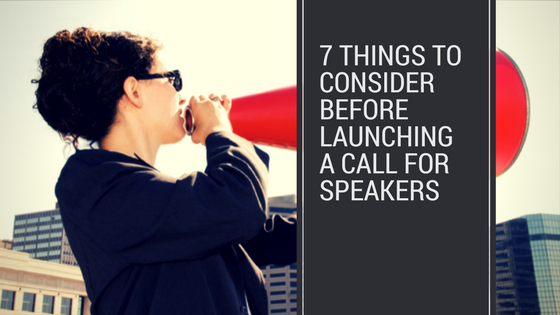
After spending a few years curating content for your event, it has gained traction to the point where people are vying for a spot on the agenda. Does this sound familiar? Nice work! Now that you’ve reached this important milestone, what should you do? You launch a Call for Speakers, of course.
A Call for Speakers (CFS) is an open invitation to your community to submit a proposal to speak at your event. This process is critical to ensuring your content measures up to attendee expectations. Therefore, it needs to be carefully planned and executed—a strategy most event planners are familiar with. In the spirit of being prepared, here are 7 things to think about before launching a CFS.
1. What are my content goals?
All events should have tangible goals, whether it’s registration revenue, the number of attendees, sponsorship dollars, or something else. The same should ring true for your agenda. Before you launch the CFS, it’s important to set realistic goals for what you want your content to achieve. You should also have your conference theme ironed-out before you set these goals as all content should drive that theme home. When goal setting, we recommend using past conference survey feedback or, if you don’t have that, reaching out to your audience for suggestions on which topics are of interest. This will help you keep your audience engaged and prevent you from making decisions in a vacuum.
Examples of content goals include:
- Number of sessions
- Tracks/topics you want to focus on
- Percentage of session type (panel, solo, co-speaker, roundtable discussion, etc.), session experience level (beginner, intermediate, advanced, etc.), and content topic
- If the conference is user-focused, what percentage of content should be devoted to your product?
- Speaker diversity (gender, role, industry, experience, ethnicity, etc.)
What event manager doesn’t love a good timeline? The CFS is a crucial part of any project plan, as the content and speakers collected from it drive many other decisions related to the conference, i.e. registration, hotel, and marketing deadlines. When thinking about the timing of your CFS, it is important that it’s launched close enough to the conference to ensure timely content but far enough in advance that you have a reasonable amount of time to manage the process efficiently. An example timeline from CFS launch to a published agenda is detailed below (all subject to the size of your conference, the number of submissions you receive, and the complexity of your review process):
- CFS duration: Typically 4-6 weeks (we recommend doing a soft close, where you then announce an extension, followed by a hard close a week later)
- Select and schedule sessions: 2-6 weeks
- Following scheduling, notify speakers: 2-3 weeks
- Allow speakers time to confirm: 1-2 weeks
- Publish agenda: 1-2 weeks after speakers confirm and 2-4 months before event
- Overall launch CFS to publish agenda: 4-5 months
3. What technology am I using to run the Call for Speakers?
Before launching your CFS, it’s important to select a platform that will make the process as seamless as possible. There are a variety of options, but ultimately it needs to be easy to use and should accommodate all your requirements. Here are some questions to ask before selecting the technology that will run your CFS:
- Is it part of, or does it integrate with an Event Management Software platform (Cvent, RainFocus, Hubb, etc.)?
- Can it connect to your website/CMS? Do you need it to?
- Can it map to all of the steps in your review process?
- How manual is it? Does it rely too much on spreadsheets or can submissions be easily reviewed in the tool?
4. What should I ask speakers to submit?
No pressure but… everything hinges on this! To ensure you receive excellent content, you need to ask the right questions and set submitters up for success. The best way to do this is to provide detailed instructions on how to submit, as well as examples of acceptance-worthy content. Check out here, here, and here for some inspiration on how to do this.
After taking part in hundreds of Calls for Speakers, here are some of the most common things we’ve seen asked for in a submission:
- Session title
- Abstract (with a limit of anywhere from 400-800 characters – this is usually based on where abstracts will display in digital or printed materials, so keep that mind)
- Short abstract (something for the mobile app, usually a limit of 200 characters)
- Track/Topic affiliation
- Session type (panel, solo, co-speaker, roundtable discussion, etc.)
- Session level (beginner, intermediate, experienced, etc.)
- Target audience (industries, roles, years of experience, etc.)
- Concrete takeaways/learning objectives (these should be short and specific, i.e. 3 bullets)
- Examples of prior speaking experience (could also include links to videos)
- Speaker background info (bio, contact information, social media handles, etc.)
- Submitter background info (in the case that the submitter is not the speaker)
Additional questions that can be asked:
- Has the content been presented at any other events? If so, how recently?
- What dates/times are you available to speak throughout the conference? This will make scheduling easier once sessions are accepted.
- Has the speaker published any books/articles related to his or her topic?
- If your agenda has different session lengths (30 min, 60 min, etc.), what is the preferred length?
5. How will I promote the Call for Speakers?
In order to find the right speakers for your event, you need to make sure your Call for Speakers is mentioned where your industry’s audience congregates online. More importantly, it should be communicated in a timely manner so there is adequate time to apply. The best way to do this is to create a marketing campaign with realistic goals and attainable deadlines.
When thinking about your campaign goals, it’s important to remember that not every submission you get will be approved. Therefore, you need to make sure you have a surplus of submissions and you have a sense of what percentage you will accept. For example, if you are trying to fill 50 slots, and you believe 25% will get accepted, make sure you are targeting 200 submissions.
Here are a few marketing strategies to get you started:
- Blog posts. Be creative with these. Don’t just mention the CFS and relevant deadlines. Give examples of quality submissions and explain why it’s a good idea to speak. Interviews with former speakers (especially in video form!) could also serve as interesting blog content. As always, make sure these don’t feel like spam. Keep them short and use them to drive your audience towards your website.
- Social media. Be sure to test different strategies for each social network, rather than writing one post and sharing it throughout. Your content should also be educational here, rather than just promotional. If you have the budget for it, using paid ads is another way to target your audience through social media.
- Industry influencers. Who are the major players in your industry? Get them involved if you can. Offer to provide some content for their blogs or let them take over one of your social media accounts for the day. The more you can associate thought leadership with your event, the better it is for your CFS.
6. Who’s on my content team?
This does not have to be a solo endeavor. More likely than not, you will need help selecting (and potentially managing) speakers. Many of our clients invite a group of industry insiders or product experts into the process to help decide on the best proposals to fill the agenda. Usually this group is known as your Program Committee, Content Review Board, or Track/Category Leads. These individuals can also be tapped to help promote the Call for Speakers and shape your content strategy.
Your content team also matters once your speakers have been selected. Depending on the number of speakers you have, it might make sense to outsource the speaker management process so you can focus on being the internal advocate for all things content.
7. How do I tackle the submission review process?
Now here’s the fun part! Once your CFS closes, it’s time to choose the best content for your audience. It’s important to give yourself enough time to do this thoughtfully. Depending on the number of submissions you are reviewing, it can take anywhere from 2 to 6 weeks devoted to this step. Make sure an initial scrub is done to eliminate incomplete submissions, proposals riddled with grammatical errors, or ideas that aren’t fully thought-out. Once you have identified your content team (see previous section), take an approach of “divide and conquer” when it comes to reviewing the submissions. We recommend sorting the submissions by track or topic but do what works best for your event. The selection process can be done in person, as a group, or individually using event management software or the old standby—spreadsheets. It’s important to think through the process from start to finish before deciding which method you are going to use.
Conclusion
Do you feel ready to launch your Call for Speakers? We hope so! To summarize, before you get started you need to:
- Establish content goals using the conference theme and attendee feedback
- Create a CFS project plan that takes timely content and task duration into account
- Decide on the software or tools you will use to manage the CFS
- Outline the list of questions you will ask submitters to complete
- Generate a multifaceted marketing plan that will target the audience you want to apply
- Enlist your content team
- Set the standards by which you will review content
Hungry for more event content information? Make sure to check out 6 Steps to Create an Engaging Panel Discussion.


 404-296-5282
404-296-5282 3237 Satellite Blvd
3237 Satellite Blvd